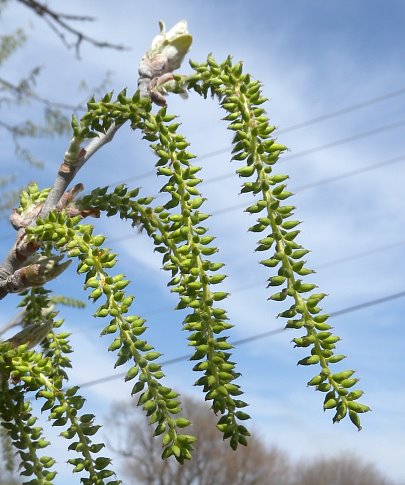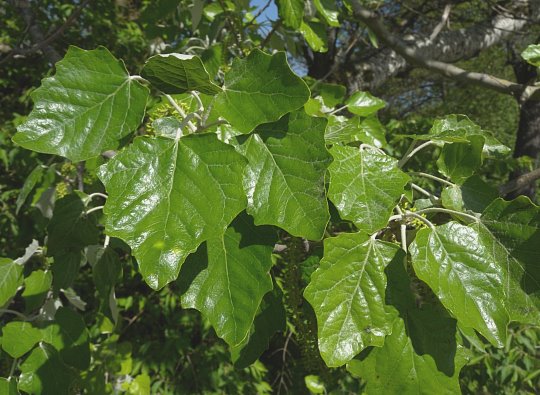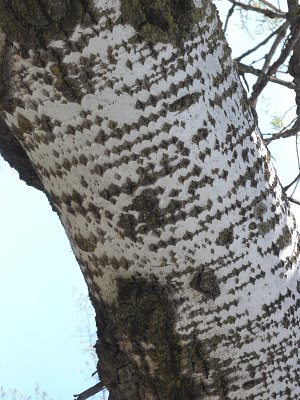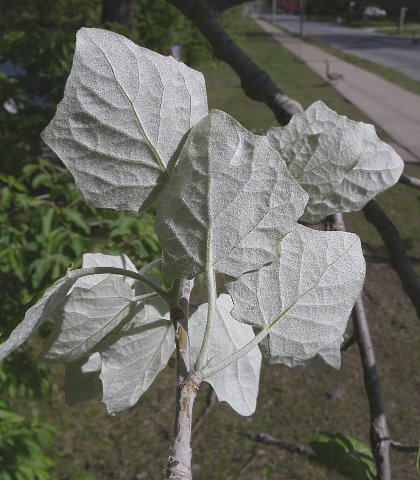
White Poplar is dioecious, forming staminate (male) and pistillate (female) catkins on separate trees. Staminate catkins are 1-3" long and drooping; they are hairy and brown while immature, becoming more red at maturity. Each staminate catkin consists of a dense aggregation of staminate florets and their bracts along its length. Each staminate floret consists of 6-12 stamens that develop from a cup-like disk; the adjacent staminate bract is narrowly oval in shape, toothed toward its apex, and ciliate. Each pistillate catkin consists of an aggregation of pistillate florets and their bracts along its length. Each pistillate floret consists of a naked ovary with a pair of deeply bifurcated stigmata; the adjacent pistillate bract is narrowly oval in shape, toothed toward its apex, and ciliate. The blooming period occurs from mid- to late spring, lasting about 1 week. The florets are cross-pollinated by the wind. Afterwards, the pistillate catkins become 2-4" long, forming seed capsules on short pedicels (less than 1 mm. in length). Individual seed capsules are 4-6 mm. in length and narrowly pyriform (pear-like) in shape. They are light green while immature, later turning brown and splitting open to release their cottony seeds (2 seeds per capsule). Individual seeds are about 1.5 mm. in length; they are enveloped in basal tufts of fine white hairs and distributed by the wind. The root system is relatively shallow and spreading, sometimes forming clonal shoots that can be located many feet away from the mother tree.

Cultivation: The preference is full or partial sun, moist well-drained conditions, and soil containing loam, silt, or calcareous sand. Growth and development are fairly rapid – some trees can develop catkins in as little as 5-7 years. Most specimens of White Poplar in North America are female trees; male trees are uncommon. As a result, the seeds of most female trees are infertile, although occasionally they can produce fertile seeds by hybridizing with other species of aspen and poplar. Should both staminate and pistillate catkins develop on the same tree, it is mostly like a hybrid.
Range & Habitat: The introduced White Poplar is occasional in most areas of Illinois (see Distribution Map). It was introduced into North America from Eurasia as an ornamental landscape tree. Habitats of naturalized trees include grassy meadows, open wooded areas, borders of ponds and lakes, urban parks, abandoned homestead sites, fence rows, and vacant lots. Such naturalized trees typically colonize habitats with a history of disturbance in urban and suburbans areas. White Poplar is still cultivated as a landscape tree, although its popularity has declined in recent years.

Faunal Associations: The larvae of several beetles bore through the wood of Populus spp. (Poplars). These species include Descarpentriesina cyanipes (Eastern Poplar Buprestid), Dicerca tenebrica (Flat-Headed Poplar Borer), Oberea delongi (Poplar Twig Borer), Saperda calcarata (Poplar Borer), Cryptorhynchus lapathi (Poplar & Willow Borer), and others. Other insect feeders include Polydrussus impressifrons (Pale Green Weevil), the plant bug Tropidosteptes populi, Pemphigus populi-transversus (Poplar Petiole Gall Aphid) and Thecabius populiconduplifolius (Folded-Leaf Poplar Aphid), the leafhopper Kybos copula, and larvae of the Cimbicid sawfly Trichosoma triangulum. In addition to these insects, the larvae of several moths feed on poplars, including Acossus centerensis (Poplar Carpenter Worm), Paranthrene tabaniformis (Poplar Clearwing), Sesia tibialis (Cottonwood Crown Borer), Phyllocnistis populiella (Poplar Serpentine Leafminer), Gluphisia septentrionalis (Common Gluphisia), Odontosia elegans (Elegant Prominent), Homoglaea hircina (Goat Sallow), and Pachysphinx modesta (Big Poplar Sphinx). Some vertebrate animals also use these trees as sources of food and shelter. The Ruffed Grouse and Purple Finch feed on the buds, while the Red-Breasted Nuthatch constructs nests in the holes of dead poplar trees. The Cottontail Rabbit and Meadow Vole gnaw on the relatively smooth bark of young trees during the winter. Beavers feed on the bark and wood of both young and mature trees throughout the year when they grow near sources of water. White-Tailed Deer and other hoofed mammalian herbivores occasionally browse on the foliage and twigs of young trees.

Photographic Location: Along a small lake at Crystal Lake Park in Urbana, Illinois.
Comments: Although it is not native to North America, White Poplar has attractive bark and bicolored leaves. The wood of this tree is relatively soft and weak; it has been used to make boxes and crates, cheap backing for furniture, or as a source of cellulose. The roots of Poplars (Populus spp.) form symbiotic relationships with ectomycorrhizal fungi; an example of such a fungus is the edible Leccinum aurantiacum (Orange Oak Bolete). Another edible fungus, Lentinus tigrinus (Tiger Sawgill), develops on stumps, logs, and dead branches. White Poplar can hybridize with several other poplars, and such hybrids occasionally naturalize. The best known hybrid is probably Populus × canescens (Gray Poplar), which is the result of a cross between Populus alba (White Poplar) and Populus tremula (European Aspen). Gray Poplar is similar to White Poplar, but the undersides of its leaves are less white. Other poplars in Illinois also have leaf undersides that are either less white from fine hairs or they are glabrous. Another distinction involves the shape of the leaves: White Poplar has large blunt teeth along its leaf margins, or its leaves are palmate with 3-5 blunt lobes. Other poplars usually have leaves with smaller teeth along their margins or they lack lobes altogether.